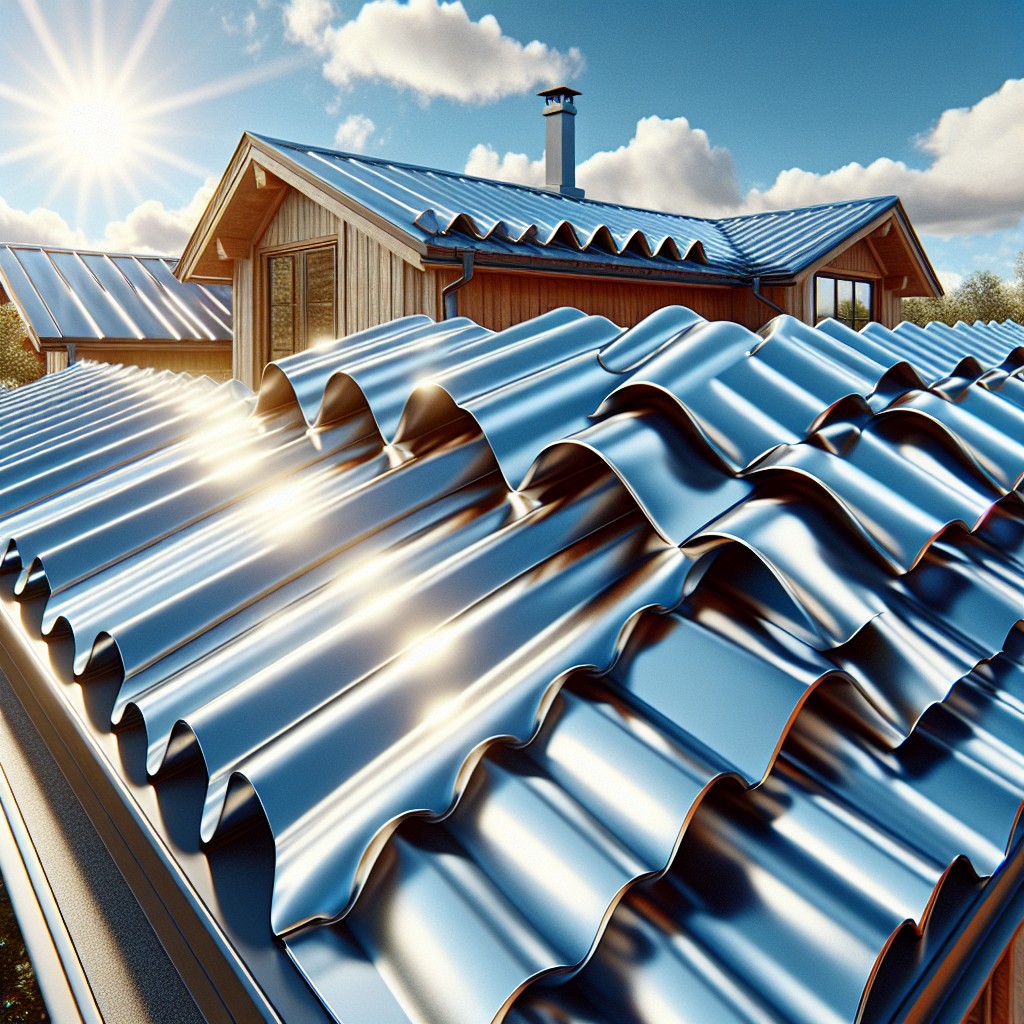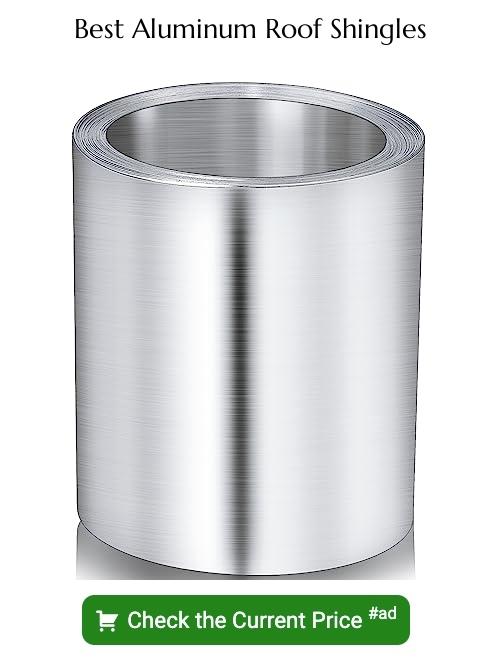Last updated on
Discover the world of aluminum shingles, their distinguishing features, advantages, and care requirements because a well-informed choice can greatly enhance the lifespan, aesthetics, and cost-effectiveness of your roofing solution.
Aluminum shingles embody the synergy of durability and performance in modern roofing solutions. Catering to homeowners seeking resilient, cost-efficient, and environmentally friendly options, this roofing choice stands out with its exceptional energy efficiency and fire-resistant properties.
Installation of aluminum shingles is meticulous, requiring precise assessment and the secure interlocking of each shingle to harness its full potential. With a lifespan that surpasses many traditional materials, it’s clear why these shingles not only excel in safeguarding your home but also in reducing long-term maintenance needs.
In the subsequent sections, we’ll delve into the comprehensive benefits and practical considerations of aluminum shingles to guide those ready to elevate their home roofing standards.
Key takeaways:
- Aluminum shingles are lightweight and durable.
- They offer energy efficiency and fire-resistant qualities.
- Installation process includes careful assessment and interlocking shingles.
- Aluminum shingles are cost-effective with a long lifespan.
- They outperform other materials in durability and maintenance requirements.
Overview of Aluminum Shingles

Aluminum shingles offer a modern twist on classic roofing materials. Lightweight and durable, they consist of interlocking metal panels engineered to mimic traditional shingle designs.
Versatility in color and style allows these shingles to complement a variety of architectural aesthetics, from quaint cottages to contemporary homes. Aluminum’s natural resistance to rust and corrosion extends the life expectancy of roofs, making it a smart investment for homeowners searching for a long-term solution.
With their reflective surface, they contribute to improved energy efficiency by deflecting sunlight, reducing the need for excessive air conditioning. Lastly, their fire-resistant qualities provide an extra layer of safety for residential properties.
Characteristics of Aluminum As a Roofing Material

Aluminum stands out for its lightweight nature, significantly reducing weight strain on a building’s structure. This property allows for easier handling and installation.
Furthermore, the material exhibits exceptional resilience against corrosion, making it ideal for coastal environments where salt spray is prevalent.
Its reflective surface contributes to energy efficiency by deflecting UV rays, thus keeping buildings cooler during the summer months. Aluminum is also malleable, permitting an array of design options to complement different architectural styles.
Durability is another hallmark of aluminum, with a lifespan often exceeding 50 years under proper maintenance. Moreover, it is impervious to common roofing problems such as cracking, shrinking, and eroding over time.
Finally, aluminum’s innate recyclability aligns with eco-friendly building practices.
Advantages of Aluminum Shingles
Aluminum shingles boast a lightweight design, easing the strain on a building’s structure and simplifying the installation process. Their inherent durability resists corrosion and can withstand extreme weather conditions, making them a long-lasting roofing option.
Energy efficiency is another core benefit, as aluminum reflects solar heat, reducing cooling costs during warmer months. Maintenance requirements are minimal given the material’s resistance to rust and rot. Additionally, aluminum’s versatility allows for a variety of styles and colors, accommodating diverse architectural aesthetics.
Sustainability is also a key advantage, as aluminum shingles are often made from recycled materials and are fully recyclable at the end of their life cycle.
Installation Process of Aluminum Shingles
Aluminum shingle installation begins with a careful assessment of the roof structure to ensure it can support the new material. Next, installers lay the underlayment, which is an essential barrier against moisture. Over this, they affix the edging strips that outline the roof’s perimeter, providing a neat finish and aiding water runoff.
Shingles are then installed from the bottom edge of the roof upwards, with each piece interlocking to maintain a watertight seal. These shingles are lightweight, allowing for quick handling and placement. Furthermore, aluminum’s malleable nature facilitates trimming and fitting around vents, chimneys, and other roof features without the need for heavy tools.
Special attention is paid to the ventilation to prevent moisture buildup, which is important for maintaining roof integrity. Manufacturers often provide specific flashing components made of the same material, ensuring a cohesive look and performance.
Fasteners, typically rust-resistant nails or screws, are used discreetly to secure shingles in place without compromising the roof’s appearance. Lastly, caps are added at the peaks and ridges, sealing the roofing system and completing the installation process.
Cost Analysis of Aluminum Shingle Roofing Systems
Aluminum shingles represent a cost-effective option when considering lifetime value. Initial installation costs are typically higher than asphalt shingles, ranging between $7 and $9 per square foot. This upfront investment is offset by the shingles’ longevity, often spanning over 50 years with minimal maintenance expenses.
Durability plays a pivotal role in their cost efficiency. Aluminum’s resistance to rust and corrosion translates to fewer replacements and repairs. Furthermore, aluminum roofs are known for their energy-saving properties. Reflecting radiant heat reduces cooling costs by up to 20%, according to the Cool Metal Roofing Coalition.
Insurance premiums may also be lower due to aluminum’s fire-resistant qualities and ability to withstand extreme weather conditions. This resilience can lead to fewer insurance claims over the life of the roof.
Recyclability also factors into the long-term economics. Aluminum shingles can be recycled, reducing waste and potentially providing a small return on the material at the end of its lifecycle.
It’s advisable for homeowners to consider both the short-term and long-term financial implications to fully assess the cost benefits of aluminum shingle roofing systems.
Interlock Aluminum Roofing System Overview
The Interlock Aluminum Roofing System utilizes a unique four-way interlocking design, which enhances its durability and resistance to weather.
Here are some key points about this system:
- Weather Resistant: The interlocks on all four sides of the shingle create a tight seal, protecting against harsh weather conditions, including heavy rain, snow, and wind.
- Longevity: Thanks to the inherent properties of aluminum and the interlocking technology, these roofs often last longer than traditional roofing materials, reducing the need for replacements.
- Energy Efficiency: Reflective coatings on Interlock shingles can reflect solar energy, contributing to cooler attic spaces and lower cooling costs in the summer.
- Aesthetic Variety: This roofing system offers multiple profile designs, such as slate, cedar shingles, tile, and standing seam, which cater to various architectural styles.
- Low Maintenance: The system is resistant to rust and corrosion, meaning it typically requires less maintenance over its lifespan compared to other roofing materials.
- Installation: While it often requires professional installation, the lightweight nature of aluminum shingles makes for a faster and less labor-intensive setup than heavier materials like slate or clay tiles.
Comparison of Aluminum Shingles With Other Materials
Aluminum shingles offer distinct advantages and differences when measured against other roofing materials.
In durability, aluminum outperforms traditional asphalt shingles, which tend to have a shorter lifespan and greater susceptibility to wind and sun damage. Unlike aluminum, asphalt requires more frequent replacement and maintenance.
Compared to steel, aluminum is more corrosion-resistant, especially in coastal areas where salt spray is prevalent. Steel may require additional coatings for similar levels of protection, potentially increasing overall costs and maintenance requirements.
When looking at wood shakes or shingles, aluminum is a clear winner in fire resistance and doesn’t support the growth of moss or algae, which can be a common issue with wood in damp climates.
Tile and concrete shingles are very durable but significantly heavier than aluminum. This weight demands a stronger roofing support system, which can increase the complexity and expense of installation.
Slate roofs boast natural beauty and longevity, but aluminum shingles are considerably lighter and don’t necessitate the reinforced structure slate often does. In addition, aluminum is available in a variety of styles and colors, some of which mimic slate at a more affordable price and with easier installation.
Synthetics, such as rubber or plastic shingles, offer lightweight and various styles but may not match the long-term performance and recyclability credentials of aluminum.
Aluminum’s energy efficiency also stands out, as it reflects solar radiation better than most, reducing cooling costs in warmer climates. Other materials may require additional treatments or coatings to achieve similar energy-saving benefits.
Reflecting on longevity, maintenance, installation, and energy efficiency, aluminum shingles hold a competitive edge in several key areas, making them a versatile and sustainable roofing choice.
Warranty and Guarantee for Aluminum Shingle Products
When considering aluminum shingle products, it’s important to focus on the warranty and guarantee aspects. Manufacturers typically provide a limited lifetime warranty, which often conveys coverage against manufacturing defects for the time you own your home. Some warranties are also transferable to subsequent homeowners, an attractive feature if you plan to sell.
Moreover, finish warranties protect against chipping, peeling, or fading and can extend up to 40 years, depending on the brand. Do note that certain conditions like proximity to marine environments might affect warranty terms due to increased corrosion risks.
Always examine the warranty for provisions regarding wind resistance; many aluminum shingle warranties cover wind uplift if installed according to manufacturer specifications. Additionally, some manufacturers may ask for regular maintenance as a warranty condition, so heed the advised maintenance schedule to maintain validity.
It’s crucial to understand that a warranty’s length does not automatically imply superior quality; assess the comprehensive coverage details. For complete assurance, engage with reputable installers who are recognized by the manufacturers, as this can influence warranty validity and provide access to enhanced coverage options.
Environmental Impact of Aluminum Shingles
Aluminum shingles contribute positively to sustainable building practices, largely due to their recyclability. Often composed of a significant percentage of recycled material, these shingles greatly reduce the need for new raw resources. Additionally, when an aluminum roof reaches the end of its lifespan, the material can be recycled without degradation, maintaining its quality in the recycling stream.
The reflective nature of aluminum also plays a crucial role in energy efficiency. Metal roofs, including those made of aluminum, reflect solar radiant heat instead of absorbing it, which can lead to reductions in cooling costs during warmer months. This characteristic lessens the burden on HVAC systems, ultimately reducing energy consumption and greenhouse gas emissions.
Furthermore, the longevity of aluminum roofing systems means less frequent replacement is needed, resulting in fewer resources used over time. The light weight of aluminum shingles can also often be installed over existing roofs, reducing waste generated from roof tear-offs and the need for additional structural support.
In summary, the encompassing environmental benefits of aluminum shingles showcase their role in green building initiatives and the push towards more eco-friendly construction solutions.
FAQ
Are aluminum shingles good?
Aluminum shingles are considered as a good roofing option due to their longevity, requiring minimal maintenance and resistance to corrosion and fading.
How long do aluminum shingles last?
Aluminum shingles have an average lifespan of about 50 years.
Is aluminum roof cheaper than shingles?
Aluminum roofs typically cost more than shingle roofs due to factors such as material type, size, and labor intensity.
What are disadvantages of aluminum roof?
Aluminum roofs, due to their softer and more malleable nature, are susceptible to denting more easily during and after installation.
How does the performance of aluminum shingles compare to traditional roofing materials?
Aluminum shingles typically outperform traditional roofing materials in durability, weather resistance, and energy efficiency.
What is the level of maintenance required for an aluminum roof?
Aluminum roofs require relatively low maintenance, typically needing only occasional cleaning to remove debris and minor repairs if damaged.
Can aluminum shingles be installed over an existing roof?
Yes, aluminum shingles can be installed over an existing roof, provided the structure can support the additional weight.





